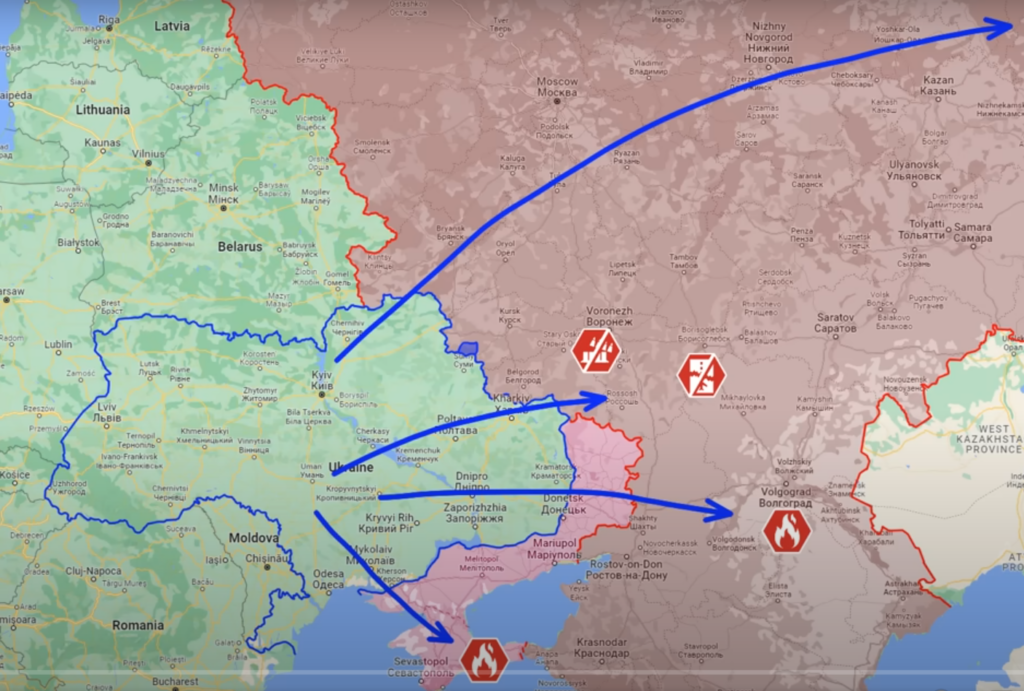Frontline report: Ukraine ignites Russian strategic bases, flames span from Crimea to Urals
In a sweeping assault igniting Russian military infrastructure across a 1,500-kilometer arc, Ukrainian forces struck strategic targets from occupied Crimea to the Urals, beginning with a devastating attack on Feodosia's port.


8 October 2024.
Today there is a lot of news from the Russian-occupied Crimea and Russia itself. Ukrainian forces continued their series of precision strikes against critical Russian military infrastructure, hitting targets within enemy territory with drones and missiles. They aimed at key assets from ammunition depots to command posts, setting the stage for a major disruption of Russian military operations.
Strike on Russian-occupied Feodosia, Crimea
First, Ukrainian drones targeted Feodosia in Crimea, striking a key Russian transshipment hub. This port infrastructure is not just an ordinary oil depot but can receive tankers with oil products year-round, store them, and distribute them across the Crimean Peninsula. Due to the attack, it sustained significant damage, and footage from the scene reveals extensive destruction, suggesting that oil logistics in the region will now rely more heavily on railways and roads, complicating transportation and hindering the Russian use of mechanized forces in Ukraine.

Strikes on fuel depots inside Russia
Just several days prior, Ukrainian Special Forces launched several swarms of drones, with their first target being a fuel storage facility near Voronezh. Despite Russian officials claiming all drones were intercepted by electronic warfare systems, footage revealed fires raging at the complex after at least one vertical fuel reservoir was struck.

A second fuel depot in the Perm region was also hit, with flames engulfing an area of 10,000 square meters. Videos shared by Russian locals on social media captured Ukrainian jet-powered missile drones flying at low altitudes and high speeds, rendering Russian defenses virtually powerless to stop them.

Borisoglebsk airfield attack
The next Ukrainian attack was aimed at the Borisoglebsk airfield in Voronezh Oblast and targeted guided air bomb warehouses, Su-35 aircraft, and their fuel storage. Locals reported Explosions and fires overnight, with satellite data showing several fire spots. While the fire may not have directly affected the planes or buildings, it could spread to nearby boxes and containers near the runway.

Destruction of Russian radar systems
Ukrainians achieved this by carefully preparing and successfully targeting and destroying a Russian 96L6 radar belonging to an S-400 air defense system around 15 km west of Belgorod. This radar can track up to 100 targets and classify them into different types: aircraft, helicopters, drones, or missiles. A Ukrainian reconnaissance drone, Shark, detected it and corrected the strike.

The second high-value target was the Russian Nebo-M radar station, which was destroyed by the Ukrainian Armed Forces using an ATACMS missile. This strike severely hampers Russia’s ability to detect, track, and intercept aerodynamic and ballistic threats within 600 km, especially as fewer than 10 systems remain operational.

Kotluban military arsenal and command post strikes
Ukrainian drone operators successfully struck the Kotluban military arsenal in Russia’s Volgograd Oblast. The attack targeted a facility used for storing and upgrading rocket artillery, which had recently received a shipment of Iranian missiles. Despite robust defenses from Russian electronic warfare and air defense systems, Ukrainian forces completed their mission, triggering massive fires and ammunition explosions.

Ukrainian forces also dealt another blow by successfully striking three key Russian command posts, including those of the 35th and 27th separate motorized rifle brigades and the command post of the Second Russian Combined Arms Army. These precision attacks using Storm Shadow missiles and GMLRS rockets were designed to disrupt Russian command operations and sow chaos in their ranks.

****
Overall, Ukraine has stepped up its efforts to deal significant blows to the enemy by targeting not only ammunition depots but all kinds of other key military infrastructure as well. While still waiting for permission to use weapon systems provided by Western partners deep inside Russia, Ukrainian armed forces are trying to deal as much damage as possible with newly developed cutting-edge missile drones just before the weather makes any significant mechanized assaults impossible and when Russians are throwing out everything at any cost to win more territory.
In our daily frontline report, we pair up with the military blogger Reporting from Ukraine to keep you informed about what is happening on the battlefield in the Russo-Ukrainian war.



